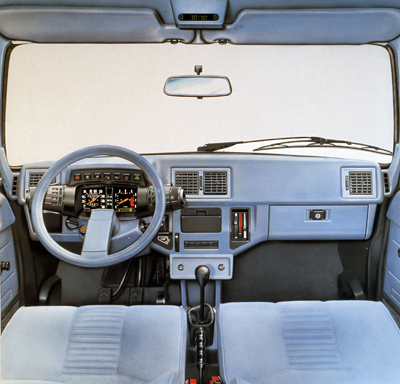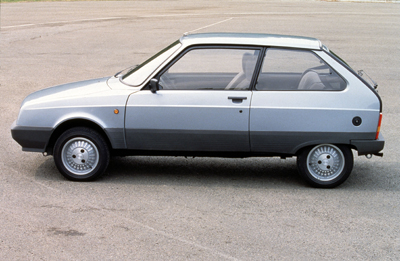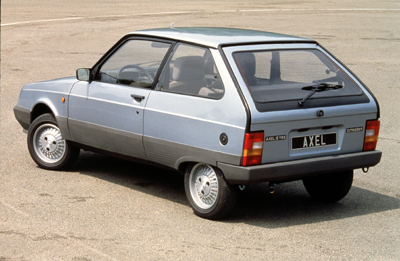|
STRONGLY BUILT
A HARD WORKER
It is a front wheel drive double body coupé,
3.72 m long; it is a five-seater with three door.
Axel is a functional model, strongly-built
and
well-adapted to the worst conditions and roads, while capable of
bearing heavy loads.
It is a multi-purpose car and is extremely
practical as it is easy to service (special equipment, easy access to
parts and driving gear).
It has excellent luggage transport and
accommodation space. Loading becomes a quick and simple affair thanks
to a tailgate that opens at bumper level. There isn’t a rear loading
plate and the back seat folds down.
Road handling is exceptional, mainly due to
having
independent long displacement shock absorbers on all four wheels, as
well as front and rear torsion bars.
SUSPENSION
– CITROËN
SAVOIR-FAIRE
The suspension has been laid out in a rather
unusual way - it is made
up of two longitudinal torsion bars linked by a transversal flexion
plate fixed to the body. It makes up a simple, robust and extremely
light unit with few anchoring points, together with a minimum amount of
bearings and articulations, (easy to set and dismount).
The needle suspension of the lower bearing
wishbone gives a soft kind
of suspension absorption, with no sign of stress marks. Two elastomere
bearings anchor the flexion plates to the body, causing longitudinal
elasticity with excellent absorption along bumpy roads. This type of
axle means that the front wheels have high displacement (170 mm).
The rear axle has been studied over a long
period of time by Citroën.
Both the hydraulic version (GSA, CX, BX) and the mechanical version,
constitute a modern solution to suspension problems, (it has since been
adopted by Peugeot). At the same time it forms a rigid unit taking up
little space. It is placed under the floor-board leaving the luggage
room entirely free (no bumps or dents).
This solution has been adopted on the GS
since I970.
A U-shaped axle frame is placed
horizontally,(opening to the rear), and
is fixed to the body with rubber silent blocks which filter the bearing
noises.
Two smooth bearings allow the suspension
arms to rotate partially around the crosshead.
They are upheld laterally by torsion bars on
either side according to
the layout. Longer arms can thus be assembled thereby increasing
flexibility (235 mm wheel displacement).
The relatively short suspension arms ensure
variable flexibility
according to the load transported - it is rather soft when the vehicle
is not transporting any goods, hardening with increasing loads. This
improves the comfort and loading capacity of the vehicle.
ENGINE AND
GEARBOX
THE GSA
EXPERIENCE
The engine gearbox unit is particularly well built. It is derived from
the GSA and benefits from its experience.
The flat four cylinder alloy engine is air cooled (no water circuit or
cylinder head gasket).
It has an overhead camshaft driven by a cogged belt.
The alloy gearbox is placed to the rear of the engine in the axis of
the vehicle. It is identical to the GSA gearboxes with similar gear
ratios.
They may be four (standard) or five (optional) speed gearboxes.
|

|

|

|

|
TRIPLE AXEL
AND DOUBLE ENTREPRISE
Axel may be delivered in one of many versions -
three
versions for private use and two “Entreprise” versions, with two
different motors and two different levels of finishings.
Axel, Axel 11R and Axel Entreprise (engine: ll29cc
delivering 57.5 bhp equipped with a four speed gearbox), Axel 12 TRS
and Axel 12 TRS Entreprise (engine: 1129cc delivering 61.5 bhp equipped
with a five speed gearbox).
Axel in its different versions completes the
Citroën
range and can be found on two markets - for small car buyers and
Entreprise (company) car buyers.
Buyers of small practical vehicles require useful
cars
with roomy accommodation, capable of transporting large loads, (large
load volume, easy access to boot).
In the lower range, one out of five buyers uses
his car
“often” to transport luggage or parcels. .. whether for business,
family or leisure reasons. This kind of customer (usually ex-Ami 6 or
Ami 8 owners) are looking for a reasonable car corresponding to their
needs – a useful, reliable and pleasant kind of car.
The “Entreprise” market (cars transformed in to
utility
cars according to precise rules and regulations such as no rear seats)
made up a total of about 850,000 vehicles in France, in 1983. The
market is mainly made up of lowerand middle range vehicles.
The buyers are usually people who buy cars for
their own
private use and use them to transport objects for work. This is why
they are looking for good loading space (1102 cm3 for the Axel 12 TRS
Entreprise with the seat down), cheap price and lower VAT rate (18.6 %
instead of 33 %). As a result of its lower price and practicality, Axel
should be one of the most competitive cars on the market.
ASSEMBLED IN OLTENIA
Oltcit,
a Franco-Roumanian group with 64% of its capital coming from
the Roumanians, was created at the end of 1976. According to the
contract signed at the time, Citroën was to provide a turnkey plant,
for the construction of a car (Axel), while also handing over the
licence.
This agreement has generated a considerably
important increase in
the number of orders placed with Citroën as well as with French
machine-tool and equipment constructors. (A third of total machine-tool
orders for France in 1978 and 1979 for example).
Machine, installation and engineering sales
represented
approximately 3 million hours of labour for Citroën workers throughout
France to manufacture the capital goods, 500,000 hours for engineering
and general method designs, and 500,000 hours to work on plans for the
vehicle.
Situated near Craiova in the Roumanian province of Oltenia, the Oltcit
plant covers a total surface area of 350,000 m - over 114 hectares of
grounds.
Except for foundry and iron work, all the
activities dealing with
the manufacturing of the car are carried out on the premises. 5,500
people are employed in two shifts.
The plant consists of a central parts shop and six
production
buildings - stamping, welding bodywork assembly, painting of small
parts and mechanized welding, assembly and machining.
The stamping building is equipped with 107 single
and double action
cutting and stamping presses varying from 80 - 1,400 tonnes. There are
also similar small presses to those at the St-Ouen Citroën plant near
Paris.
The bodywork assembly building is made up of 12
automatic welding
lines, with an assembly line which measures some 127 metres. The
techniques used are identical to those used at the Citroën Rennes - La
Janais plant, whereas the assembly procedure of the lower car body is
unique to Oltcit.
The same techniques and installations as at the
Aulnay plant can be
found in the painting department. It is equipped with electrophoresis
installations as well as robots for priming and lacquering.
In the bodywork assembly unit number II, engine
accessories are
manufactured, such as air ducts and pedals, as well as exhaust pipes
and petrol tanks.
In painting department II, the exhaust pipes are
covered in high
heat-resistant paint. Ultra-modern zinc covering methods are being
developed here.
The machining building is equipped with 42
automatic transfer lines, of which 4 are engine assembly lines.
Finally, the assembly and finishing lines are very
similar to the
assembly lines found in France. 59 conveyors and 255 transporters have
been installed to make up a total length of 34 kilometers.
The plant comprises 32 programmable automatic
machines.
One of the main characteristics of Oltcit is its
aim to achieve high quality products.
Devices to continually control and check the
quality of the products
at all stages of manufacturing have been installed - control points,
testing stations, metallurgic and chemical labs, metrological workshops
integrated with each technique which are air conditioned and equipped
with three dimensional processing machines. All cars coming off the
assembly lines are systematically tested.
|